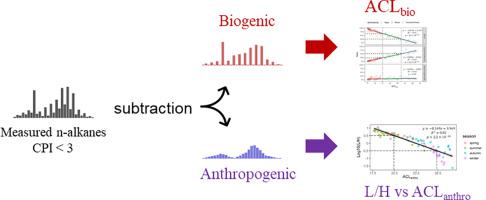Science of the Total Environment ( IF 9.8 ) Pub Date : 2020-06-27 , DOI: 10.1016/j.scitotenv.2020.140517 Yong He 1 , Chen Yang 1 , Wei He 1 , Wenxiu Liu 1 , Fuliu Xu 1

|
N–alkanes are ideal molecular markers for the source apportionment of organic matter. However, the estimation of both biogenic and anthropogenic sources under mixed scenario using n–alkanes and their related proxies still remains an issue. In this study, we investigated spatiotemporal variations of n–alkanes in suspended particulate matter of Lake Chaohu for their source apportionment. Overall, Σ29 n–alkanes ranged from 324.1 to 113685 ng·L−1. C17H36 was the most abundant homologue and was followed by C18, C27 and C29 homologues. Carbon preference indexes (CPIs) in most samples (at least 85%) were < 3, indicating mixed sources of n–alkanes in Lake Chaohu. Therefore, biogenic and anthropogenic n–alkanes were separated by subtraction to avoid potential bias. Our results showed Σ biogenic and Σ anthropogenic n–alkanes ranged from 14.8 to 3531.6 ng·L−1 and 257.6 to 4938.5 ng·L−1, respectively. For biogenic n–alkanes, their carbon–chain distributions posed a preponderant peak at C17, indicating algae were the main contributors to biogenic n–alkanes in Lake Chaohu. Biogenic average chain length (ACLbio) was developed to quantify the contributions of different biogenic sources. We recommended ACLbio < 21 for algae dominance and ACLbio > 26 for terrestrial plant dominance. For anthropogenic n–alkanes, their carbon–chain distribution presented obviously spatiotemporal variations. The sources of anthropogenic n–alkanes in summer and winter were typical dominances of light petroleum and incomplete fossil fuel burning/heavy oil emission, respectively. New developed proxies, anthropogenic average chain length (ACLanthro) and the ratio of unit short– to long–carbon anthropogenic n–alkanes (L/H), are effective for quantifying the relative contributions of different anthropogenic sources. We recommend log10L/H > 0.5 and ACLanthro < 20.5 for light petroleum input dominance, log10L/H < −0.5 and ACLanthro > 26.5 for incomplete fossil fuel burning at high temperature/heavy oil emission dominance.



























 京公网安备 11010802027423号
京公网安备 11010802027423号